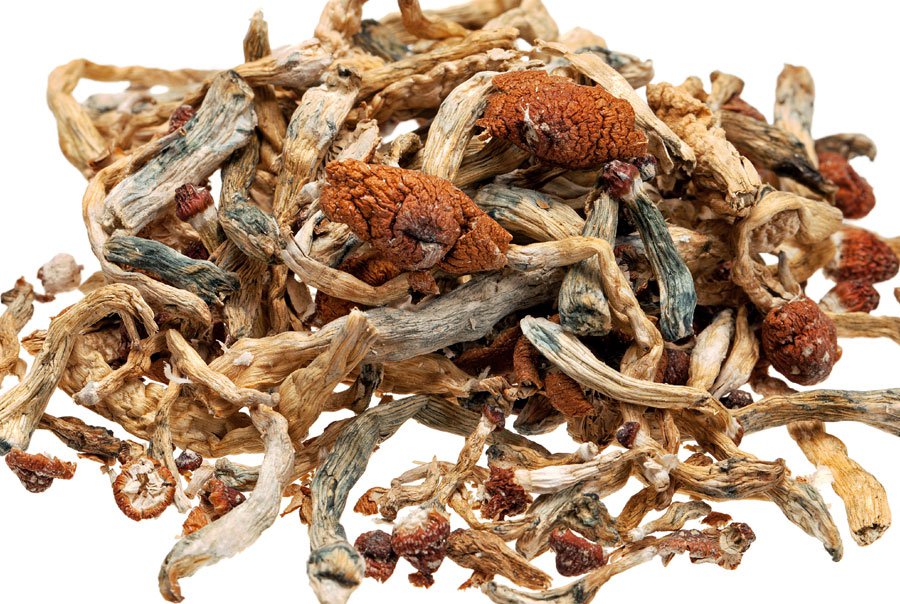Psilocybin (magic mushrooms)

Last published: November 22, 2023
What are magic mushrooms?
Psilocybin or magic mushrooms are naturally occurring and are consumed for their hallucinogenic effects.
They are psychedelic drugs, which means they can affect all the senses, altering a person’s thinking, sense of time and emotions. Psychedelics can cause a person to hallucinate, seeing or hearing things that do not exist or are distorted.1
The key ingredient in magic mushrooms is psilocybin. When psilocybin is taken, it’s converted in the body to psilocin, which is the chemical with the psychoactive properties.2
What do magic mushrooms look like?
Magic mushrooms look much like ordinary mushrooms.
There are many different types of magic mushrooms. The most common ones in Australia are called golden tops, blue meanies and liberty caps.3 Magic mushrooms look similar to poisonous mushrooms that can cause a person to become very sick and can result in death.
They can also come as dried material in capsules. Synthetic psilocybin appears as a white crystalline powder that can be processed into tablets or capsules or dissolved in water.4
Other names
Shrooms, mushies, blue meanies, golden tops, liberty caps.
How are magic mushrooms taken?
Magic mushrooms are eaten fresh, cooked or brewed into a tea. The dried version is sometimes smoked, mixed with cannabis or tobacco.
Effects of magic mushrooms
There is no safe level of drug use. Use of any drug always carries some risk. It’s important to be careful when taking any type of drug.
Magic mushrooms can affect everyone differently, based on:
- size, weight and health
- whether the person is used to taking it
- whether other drugs are taken around the same time
- the amount taken
- the strength of the mushroom (varies depending on the type of mushroom)
- the environment (where the drug is taken)
The effects of magic mushrooms usually begin in 30 minutes when eaten, or within 5–10 minutes when taken as a soup or tea and can last approximately four to six hours.3
During this time, the person may experience:
- euphoria and wellbeing
- change in consciousness, mood, thought and perception (commonly called a trip)
- dilation of pupils
- perceptual changes, such as visual and auditory hallucinations (seeing or hearing things that aren’t there, or are distorted)
- stomach discomfort and nausea
- headaches
- fast or irregular heartbeat
- increased body temperature
- breathing quickly
- vomiting
- facial flushes, sweating and chills.1,3
Overdose
The use of magic mushrooms rarely results in any life-threatening symptoms. If a large amount or a strong batch of mushrooms is consumed, the person may experience:
- agitation
- vomiting
- diarrhoea
- muscle weakness
- panic or paranoia
- psychosis
- seizures
- coma. 4,5
Bad trips
Sometimes a person may experience the negative effects of magic mushrooms and have a ‘bad trip’.
A bad trip might include:
- unpleasant or intense hallucinations
- anxiety
- paranoia
- panic or fear.5,4
Coming down
After taking magic mushrooms, delayed headaches can happen. These usually don’t last longer than a day.5
A person who has taken mushrooms may experience feelings of:
- exhaustion
- depression
- anxiety. 3
Some people who regularly use magic mushrooms may experience flashbacks involving a previous magic mushroom experience. They are usually visual distortions that involve changes in your emotions or perception.
Flashbacks can happen weeks, months or even years after the drug was last taken. This can be disturbing, especially if a frightening experience or hallucination is recalled. Flashbacks can be brought on by using other drugs, stress, tiredness or exercise and usually last a minute or two.3,4
Impact of mood and environment
Drugs that affect a person’s mental state (psychoactive drugs) can also have different effects depending on a person’s mood (often called the ‘set’) or the environment they are in (the ‘setting’).
Set is a person’s state of mind, previous encounters with psychedelic drugs, and expectations of what’s going to happen. For example, feelings of stress or anxiety before using magic mushrooms may result in a bad trip.6
Setting is the environment in which someone takes a psychedelic drug – whether it’s known and familiar, who they’re with, if they’re indoors or outdoors, the type of music and light. For example, using magic mushrooms in a calm, quiet and relaxed environment can lead to, or contribute to, a pleasant experience but being in a noisy, crowded place may result in a negative experience.6
Being in a good state of mind, with trusted friends and a safe environment before taking magic mushrooms reduces the risk of having a bad trip.
Using magic mushrooms with other drugs
The effects of taking magic mushrooms with other drugs − including over-the-counter or prescribed medications − can be unpredictable and dangerous.
Magic mushrooms + ice, speed or ecstasy: Can increase the chances of a bad trip and lead to panic.7
Magic mushrooms + some psychiatric medications: Mushrooms should not be taken by people on psychiatric medications as a relapse or worsening of the condition could occur.
‘Polydrug use’ is a term for the use of more than one drug or type of drug at the same time or one after another. Polydrug use can involve both illicit drugs and legal substances, such as alcohol and medications. Find out more about polydrug use.
Tolerance and dependence
Tolerance develops rapidly with continued use, resulting in the drug having little to no effect over time. Discontinuing use for a week or so will return people to their normal tolerance level.3
Health and safety
The main risk of taking magic mushrooms is that some look very similar to certain types of poisonous mushrooms. So, it’s important to know what you’re taking – if in doubt, do not take them.3
If you believe you or someone else may have eaten a poisonous mushroom, do not wait for symptoms to occur. Contact the Victorian Poisons Information Centre (13 11 26).
If the person has collapsed, stopped breathing, is having a fit or is suffering an anaphylactic reaction, immediately ring triple zero (000) for an ambulance. Ambulance officers don’t need to involve the police.
For more information on poisonous fungi, including their identification and symptoms please visit the Better Health Channel.
Withdrawal
Taking mushrooms regularly doesn’t appear to cause physical dependence, so it’s unlikely someone would find it hard to stop using mushrooms.4
There aren’t many known withdrawal effects for magic mushrooms, apart from some potential mild psychological effects or feeling tired.3
Getting help
If your use of psilocybin is affecting your health, family, relationships, work, school, financial or other life situations, or you’re concerned about a loved one, you can find help and support.
Call the National Alcohol and Other Drug Hotline on 1800 250 015 for free and confidential advice, information and counselling about alcohol and other drugs
Help and Support Services search
Find a service in your local area from our list. Simply add your location or postcode and filter by service type to quickly discover help near you.
If you're looking for other information or support options, send us an email at druginfo@adf.org.au
Path2Help
Not sure what you are looking for? Try our intuitive Path2Help tool and be matched with support information and services tailored to you.
Find out more
Federal and state laws provide penalties for possessing, using or selling magic mushrooms, or driving under their influence.
See also, drugs and the law.
According to the National Drug Strategy Household Survey 2019, in the past 12 months 1.6% of Australians aged over 14 years had used psychedelics. Of this 1.6%, 61% had used psilocybin and 73% had used LSD.8
- Nichols D. Psychedelics. Pharmacological Reviews 2016;68:264–355.
- Dinis-Oliveira R. Metabolism of psilocybin and psilocin: clinical and forensic toxicological relevance. Drug Metabolism Reviews. 2017;49(1).
- Campbell A. The Australian Illicit Drug Guide. Melbourne: Black Inc; 2001.
- Brands B Sproule B Marshman J. Drugs & Drug Abuse. 3rd ed. Ontario: Addiction Research Foundation; 1998.
- Carbonaro T Bradstreet M Barrett F MacLean K Jesse R Johnson M Griffiths R. Survey study of challenging experiences after ingesting psilocybin mushrooms: Acute and enduring positive and negative consequences. Journal of Psychopharmacology. 2016;30(12).
- Nutt D. Drugs without the hot air : making sense of legal and illegal drugs. Cambridge: UIT Cambridge Ltd; 2012.
- Black E. Polydrug use: What you need to know about mixing drugs. In: National Drug and Alcohol Research Centre UoNSW, editor. 2014.
- Australian Institute of Health and Welfare. National Drug Strategy Household Survey 2019 2020 [09.09.2020].
Explore psychedelics on the Drug Wheel
